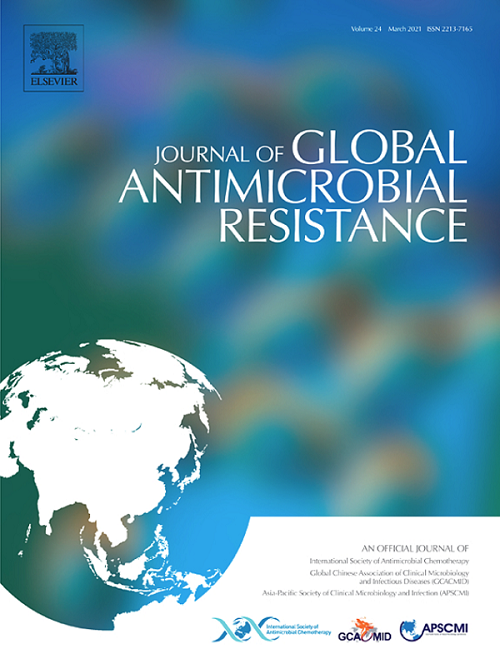临床,微生物学和实验室预测在标签和标签外达尔巴伐辛治疗失败。
IF 3.2
3区 医学
Q2 INFECTIOUS DISEASES
引用次数: 0
摘要
背景:dalbavancin治疗失败(TF)的危险因素数据缺乏。我们的目的是调查临床、微生物学和实验室预测因子在适应症和非适应症达巴伐星治疗中的TF。方法:我们纳入了2018年1月至2024年6月期间在我们中心接受至少一剂达尔巴伐辛治疗的所有患者,并收集了所有临床和实验室参数。TF定义为治疗后90天内需要再入院、急诊或死亡。通过多变量分析和Kaplan Meier曲线评估与TF和死亡率相关的因素。结果:纳入351例患者,主要为男性(60.9%),中位年龄为64岁(IQR:49.5-75.5), 55.3%的患者在急诊科/门诊接受达尔巴文星治疗,44.7%的患者早期出院,54.9%的患者超标签用药。主要的超说明书适应症为骨髓炎、假体感染和心内膜炎(分别为17.1%、8.3%和7.7%)。53.3%的病例可获得微生物分离物(49.2%为MRSA)。总体而言,TF率为19.4%。结论:观察到的TF率较高,特别是在超说明书用药和有多种合并症或静脉用药的人群中。需要更多的证据来更好地确定有效的达尔巴伐辛治疗的最佳患者概况。本文章由计算机程序翻译,如有差异,请以英文原文为准。
Clinical, microbiological, and laboratory predictors of on- and off-label dalbavancin treatment failure
Objectives
Data about risk factors for treatment failure (TF) to dalbavancin are lacking. Our aim was to investigate the clinical, microbiological, and laboratory predictors of TF in both on- and off-label dalbavancin treatments.
Methods
We included all patients who received at least one dose of dalbavancin at our centre from January 2018 to June 2024 and with available data on follow-up, collecting all clinical and laboratory parameters. TF was defined as the need for readmission, emergency department access, or death within 90 d after treatment. Factors correlating with TF and mortality rate were assessed using multivariable analyses and Kaplan-Meier curves.
Results
Three hundred fifty-one patients were included, mostly men (60.9 %), median age of 64 years (interquartile range [IQR] = 49.5–75.5), 55.3 % receiving dalbavancin in the emergency department/outpatient setting, and 44.7 % for early discharge, in 54.9 % cases as off-label. The main off-label indications were osteomyelitis, prosthetic infections, and endocarditis (17.1 %, 8.3 %, and 7.7 %). In 53.3 % of the cases, a microbiological isolate was available (Methicillin-resistant Staphylococcus aureus [MRSA] in 49.2 % of cases). Overall, the TF rate was 19.4 %. Overall, multivariable analysis showed that intravenous (IV) drug use (hazard ratio [HR] = 7.99, P < 0.001), diabetes (HR = 6.1, P < 0.001), obesity (HR = 4.5, P < 0.001), cancer (HR = 5.3, P < 0.001), HIV (HR = 4.88, P < 0.001), levels of CRP at dalbavancin treatment initiation (HR = 1.01, P < 0.001, and HR = 0.72, P = 0.02) were associated with TF. Additionally, the duration of IV antibiotic therapy before being discharged influenced outcomes in the off-label group (HR = 0.52, P = 0.02).
Conclusions
The observed TF rate was high, particularly in off-label uses and among individuals with multiple comorbidities or IV drug use. More evidence is needed to better define the optimal patient profile for effective dalbavancin treatment.
求助全文
通过发布文献求助,成功后即可免费获取论文全文。
去求助
来源期刊

Journal of global antimicrobial resistance
INFECTIOUS DISEASES-PHARMACOLOGY & PHARMACY
CiteScore
8.70
自引率
2.20%
发文量
285
审稿时长
34 weeks
期刊介绍:
The Journal of Global Antimicrobial Resistance (JGAR) is a quarterly online journal run by an international Editorial Board that focuses on the global spread of antibiotic-resistant microbes.
JGAR is a dedicated journal for all professionals working in research, health care, the environment and animal infection control, aiming to track the resistance threat worldwide and provides a single voice devoted to antimicrobial resistance (AMR).
Featuring peer-reviewed and up to date research articles, reviews, short notes and hot topics JGAR covers the key topics related to antibacterial, antiviral, antifungal and antiparasitic resistance.
 求助内容:
求助内容: 应助结果提醒方式:
应助结果提醒方式:


